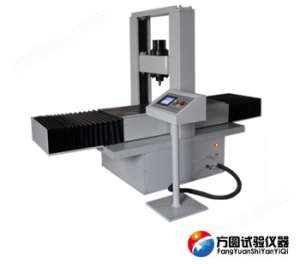Product Features
The body and workbench are constructed using precision casting technology, which is sturdy, rigid, precise, reliable, and durable;
Portal rack, large movable workbench, maximum moving distance 1000mm; (can be customized according to customer requirements)
The testing institution adopts spoke type pressure sensors; PLC anti-interference controller;
Imported servo motors, high-precision ball screws, and linear guides;
The experimental force, loading saturation time, feed rate, and testing speed can be manually adjusted and controlled;
Electronic force application, automated experimental process, no human error operation; Optional CCD image processing system;
Specially suitable for measuring the Brinell hardness of large metal parts;
The accuracy meets GB/T231.2, ISO 6506-2, and ASTM E10 in the United States.
Application and scope:
This product measures the Brinell hardness of black metals, non-ferrous metals, and bearing alloy materials;
Specially suitable for precise measurement of Brinell hardness of oversized workpieces.
Main technical parameters:
Measurement range: 32-650HBW;
Test force: 7355.3, 9807, 29421N (750, 1000, 3000kgf);
Maximum allowable height of the sample: 950mm; (can be customized according to customer requirements)
Distance between two columns: 1350mm; (can be customized according to customer requirements)
The lateral movement distance of the testing institution is 1000mm; (can be customized according to customer requirements)
Workbench size (length * width): 1500x1000mm; (Can be customized according to customer requirements)
Dimensions: Host 2000 * 1800 * 2180mm; (can be customized according to customer requirements)
Power supply: AC380,50/60Hz;
Weight: The host weighs 3000kg.
Standard accessory box:
Extra large flat test bench: 1 unit; Tungsten carbide steel ball indenter: 1 each of Φ 5 and Φ 10;
Standard Brinell hardness block: 2 pieces; 20 times reading microscope: 1 unit.
The composition of the machine:
The machine consists of a control system and a main unit.
The control system adopts Siemens PLC programmable controller from Germany.
The host body and crossbeam are precision cast, and the crossbeam is equipped with a hardness testing mechanism inside. The hardness testing mechanism includes a test force loading device and an automatic measuring device (underlined kinetic energy is optional).
The experimental force loading device adopts a fully automatic closed-loop control system.
The automatic measuring device uses a high-precision camera to capture the indentation, and the software measures the indentation to display and save the hardness test report.
Features and advantages of this machine:
The machine is equipped with: automatic feed function, high-precision positioning function, automatic testing function, automatic measurement function, set hardness range, automatic identification of unqualified warning function beyond the range, and anti-interference function of the control system.
Introduction to the working process of the machine:
After turning on the machine, first set the selected test force, then click the front and back buttons to control the movement of the worktable. Move the position of the workpiece to be tested below the hardness testing mechanism, and then click the up and down buttons to move the crossbeam up and down, so that the hardness testing mechanism moves to the optimal distance from the position of the workpiece to be tested (which can shorten the time required for testing). Then click the load test force button, and the hardness testing mechanism moves left and right along the crossbeam, completing the process of loading test force, holding test force, unloading test force, and automatic measurement of the workpiece to be tested position in sequence (underlined are optional kinetic energy). Then the hardness testing mechanism returns to the starting position, and click the button to control the worktable to exit the workpiece.


